Welcome
In celebration of the centennial year of the first issue in 1913, and building upon the foundations of the “Centennial Anthology” compiled in 2011, we feature three articles in two different formats toward consideration of The Art Bulletin’s digital future. You may look back at developments of the print journal through an interactive timeline in which all Table of Contents are grouped by decade; publishing trends and editorial statements are noted by year. Scalar, the publishing platform used here, allows further exploration of this information through links, much like a web site, and by tags, which, more than links and key words, allow the reader to select alternate presentations. Is this the kind of publishing option The Art Bulletin should consider taking advantage of in its digital future? No step into the future should be undertaken without concerted consideration by the readership of The Art Bulletin of past developments and current essential services. We ask you to explore this site, imagine the possibilities, and let us know your thoughts.
This web publication marks the second Centennial celebration of The Art Bulletin, which may rightly claim several beginnings. The first centennial celebration in 2011 marked the occasion of the foundation of the College Art Association in 1911, for which Natalie Boymel Kampen, then Chair of the Editorial Board, compiled a “Centennial Anthology” of board members’ favorite articles for the College Art Association website. Many of these articles mark key moments in the intellectual development of the discipline of art history; all reflect the social, structural, and infrastructural development of the journal. Explicit, directed involvement with the formation of the discipline is evident from the very first issues as has been noted recently in several venues. The Centennial Session, “Celebrating The Art Bulletin,” held during the 2011 annual conference looked back to articles published during the early decades of the journal’s existence. In addition, Susan Ball, executive director emerita, edited a volume of essays on the history of CAA, The Eye, the Hand, the Mind: 100 Years of the College Art Association, in which Craig Houser considered the history of The Art Bulletin along with the full slate of CAA’s scholarly publications. Following those activities, it seemed appropriate to explore new possibilities for scholarly publication on the occasion of the journal’s centennial.
In celebration of the centennial year of the first issue in 1913, and building upon the foundations of the “Centennial Anthology” compiled in 2011, we feature three articles in two different formats toward consideration of The Art Bulletin’s digital future. “Publishing The Art Bulletin: Past, Present, and Future,” presents these articles as they may be found in the journal current online format, as pdf documents presented through Jstor, and as they might be read in the tablet format that is popular now. We take a further step with one article to imagine how it might look if published with technologies presently in development. You may look back at the development of the print journal through an interactive timeline in which all Table of Contents are grouped by decade; changes in format and content (mainly through editorial statements) are noted by year.
To a great extent, this is an exercise in form and function, tracing some of the ways by which the journal came to take its present form to serve the purposes it serves now and asking what forms it might take to serve the future needs of the discipline. Intersections with content are inevitable, however content is considered here mainly as it reflects the stated concerns of the Editors-in-Chief and their Editorial Boards. Scalar, the publishing platform used here, allows further exploration of this information through links, much like a web site, and by tags, which, more than key words, allow several alternate presentations. Although arranged in the separate sections for timeline and featured articles, Scalar allows you to decide how to order your reading. Moreover, tag visualization provides impressionistic and dynamic rendering of information. You might, for example, decide to explore tags for editorial statements, advocacy, art education, or other themes. Cost has always been at issue, so changes and events associated with cost (subventions, for example, and cost increases for subscriptions) are noted all along the timeline. Charting your paths through such mundane concerns and formal changes will sketch alternate histories of the restrictions and possibilities that mitigate the aspirations of the journal's Editors and readership. (For instruction in how to use Scalar’s navigation possibilities, see this video.)
Is this the kind of publishing option The Art Bulletin should consider taking advantage of in its digital future? As the journal of record for the discipline in America, The Art Bulletin provides essential services for art historical scholarship across all fields (presenting a compendious view of ongoing research and emerging areas of common interest, as well as a platform for the peer reviewed publications so essential to tenure and promotion in the academy) with the goal of sustaining the discipline. How do you imagine the journal might exploit online opportunities while continuing to serve the discipline? No step into the future should be undertaken without concerted consideration by the readership of The Art Bulletin of past developments and current essential services. We ask you to explore this site, imagine the possibilities, and let us know your thoughts.
Thelma K. Thomas
Chair, Editorial Board
date
Further Resources
In celebration of the centennial year of the first issue in 1913, and building upon the foundations of the “Centennial Anthology” compiled in 2011, we feature three articles in two different formats toward consideration of The Art Bulletin’s digital future. “Publishing The Art Bulletin: Past, Present, and Future,” presents these articles as they may be found in the journal current online format, as pdf documents presented through Jstor, and as they might be read in the tablet format that is popular now. We take a further step with one article to imagine how it might look if published with technologies presently in development. You may look back at the development of the print journal through an interactive timeline in which all Table of Contents are grouped by decade; changes in format and content (mainly through editorial statements) are noted by year.
To a great extent, this is an exercise in form and function, tracing some of the ways by which the journal came to take its present form to serve the purposes it serves now and asking what forms it might take to serve the future needs of the discipline. Intersections with content are inevitable, however content is considered here mainly as it reflects the stated concerns of the Editors-in-Chief and their Editorial Boards. Scalar, the publishing platform used here, allows further exploration of this information through links, much like a web site, and by tags, which, more than key words, allow several alternate presentations. Although arranged in the separate sections for timeline and featured articles, Scalar allows you to decide how to order your reading. Moreover, tag visualization provides impressionistic and dynamic rendering of information. You might, for example, decide to explore tags for editorial statements, advocacy, art education, or other themes. Cost has always been at issue, so changes and events associated with cost (subventions, for example, and cost increases for subscriptions) are noted all along the timeline. Charting your paths through such mundane concerns and formal changes will sketch alternate histories of the restrictions and possibilities that mitigate the aspirations of the journal's Editors and readership. (For instruction in how to use Scalar’s navigation possibilities, see this video.)
Is this the kind of publishing option The Art Bulletin should consider taking advantage of in its digital future? As the journal of record for the discipline in America, The Art Bulletin provides essential services for art historical scholarship across all fields (presenting a compendious view of ongoing research and emerging areas of common interest, as well as a platform for the peer reviewed publications so essential to tenure and promotion in the academy) with the goal of sustaining the discipline. How do you imagine the journal might exploit online opportunities while continuing to serve the discipline? No step into the future should be undertaken without concerted consideration by the readership of The Art Bulletin of past developments and current essential services. We ask you to explore this site, imagine the possibilities, and let us know your thoughts.
Thelma K. Thomas
Chair, Editorial Board
date
Further Resources
Interactive Timeline
Featured Articles (from the Centennial Anthology)
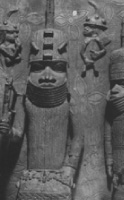
Imagining Otherness in Ivory:
African Portrayals of the Portuguese ca. 1492
Suzanne Preston Blier
Vol. 75, no. 3 (September 1993) 375–96
This page is a tag of:
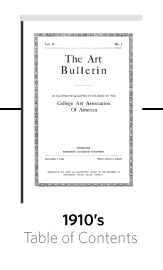




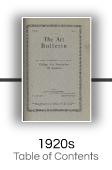





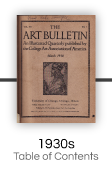


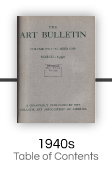




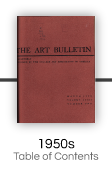



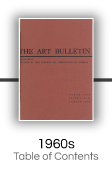




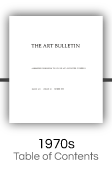


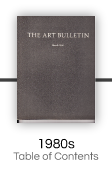



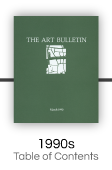

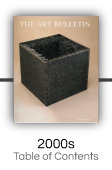








Discussion of "Welcome"
Add your voice to this discussion.
Checking your signed in status ...